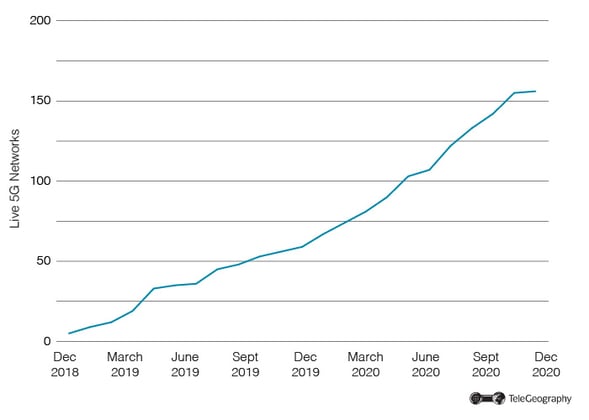More than 100 5G mobile networks went live around the world during 2020.
This included launches in Australia, Canada, Italy, Japan, Poland, Hong Kong, and Sweden.
The history of 5G takes us back to 2018 when the first 5G systems were introduced. These offerings were limited either by their geographic footprint or due to the limited choice of end-user devices available at that time.
By 2019—especially in the second half of the year—more handsets were released to the public and a growing number of operators moved to launch commercial 5G services.
One early adopter was UAE operator Etisalat, which switched on a 5G system in September 2018 but only in fixed-wireless mode. It was not until May 2019 that the first 5G-capable handsets were made available in UAE and the telco announced its full 5G launch, with rival firm Du going live only a few days later.
Steady Growth in 2020
Spread of Live 5G Networks

But the market really took off last year despite the difficulties of rolling out networks amid COVID-19 restrictions. According to TeleGeography’s GlobalComms Database, there were 155 live 5G networks worldwide by the end of 2020, up from 53 a year earlier and just a handful a year before that.
Early Auctions
One market that got its 5G spectrum auctions out of the way in 2019 was Hong Kong, with sales of 3.3GHz, 3.6GHz, 4.9GHz, and 26GHz permits taking place between March and November that year.
An auction of 600MHz and 700MHz frequencies is due to be held in 2021.
The first 5G services were introduced by HKT, 3, and CMHK on April 1, 2020—the first possible date that their new spectrum was made available for use. Fourth operator SmarTone joined the 5G market the following month.
A number of other countries had sold 5G licenses prior to that.
Italy offered frequencies in the 700MHz, 3.5GHz, and 26GHz bands in September/October 2018, with spectrum won by TIM, Vodafone, WINDTRE, Iliad, and Fastweb. Vodafone and TIM were the first to market with commercial services in June 2019.
Australia, meanwhile, conducted its own 3.5GHz sale in December 2018, with frequencies snapped up by Telstra, Vodafone/TPG, Optus, and wholesale provider Dense Air Australia.
Telstra was the first to market with 5G, making a wireless router available to consumers in May 2019, while a 5G-compatible handset followed later that month.
Some Cellcos Not Waiting for Spectrum
Operators in a number of countries have chosen to push ahead with 5G network launches even before local regulators have completed spectrum auctions, opting instead to offer services using their existing spectrum holdings.
In Poland, for example, a planned sale of licenses offering 3.6GHz-3.8GHz frequencies was postponed in March 2020 due to the COVID-19 outbreak. The auction is now expected to be held in Q1 2021, but this hasn’t prevented cellcos from rolling out 5G.
The first commercial 5G services in Poland were launched by Polkomtel/Plus in May 2020 using its existing licenses in the 2.6GHz band. The country’s other three operators chose to utilize 2100MHz spectrum that had previously been used for 3G networks. Play opened its network in June 2020, while Orange launched at the start of July and T-Mobile followed suit just days later.
It was a similar picture in Sweden prior to the delayed sale of 2.3GHz and 3.5GHz licenses in January 2021. Telia and Tele2 launched the country’s first commercial 5G networks toward the end of May 2020, with Tre joining them the following month and Telenor launching 5G in central Stockholm in October that year.
Immediately after the completion of the auction, Tele2 and Telenor announced that their network sharing joint venture Net4Mobility had used its new 3.5GHz frequencies to double download rates on its 5G infrastructure from around 500Mbps to more than 1Gbps.
The gigabit service—dubbed “real 5G” by Tele2—was made available by Tele2 in 30 Swedish cities and by Telenor in 37. By the end of 2023, the Net4Mobility partners expect to have rolled out 5G connectivity to more than 99% of Sweden’s population.
2021 is set to be as busy as last year, with dozens of operators lining up commercial 5G launches.
Pete Bell
Pete Bell is a Senior Analyst for TeleGeography’s GlobalComms Database and also contributes to the daily CommsUpdate newsletter. He has a particular interest in wireless broadband and was responsible for TeleGeography’s 4G Research Service until it was integrated into GlobalComms.


